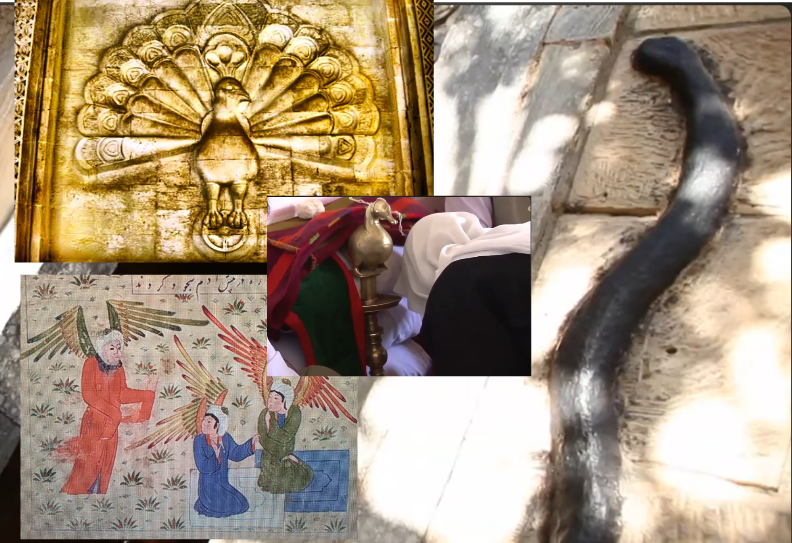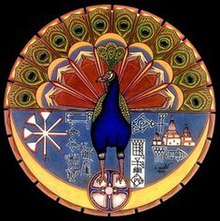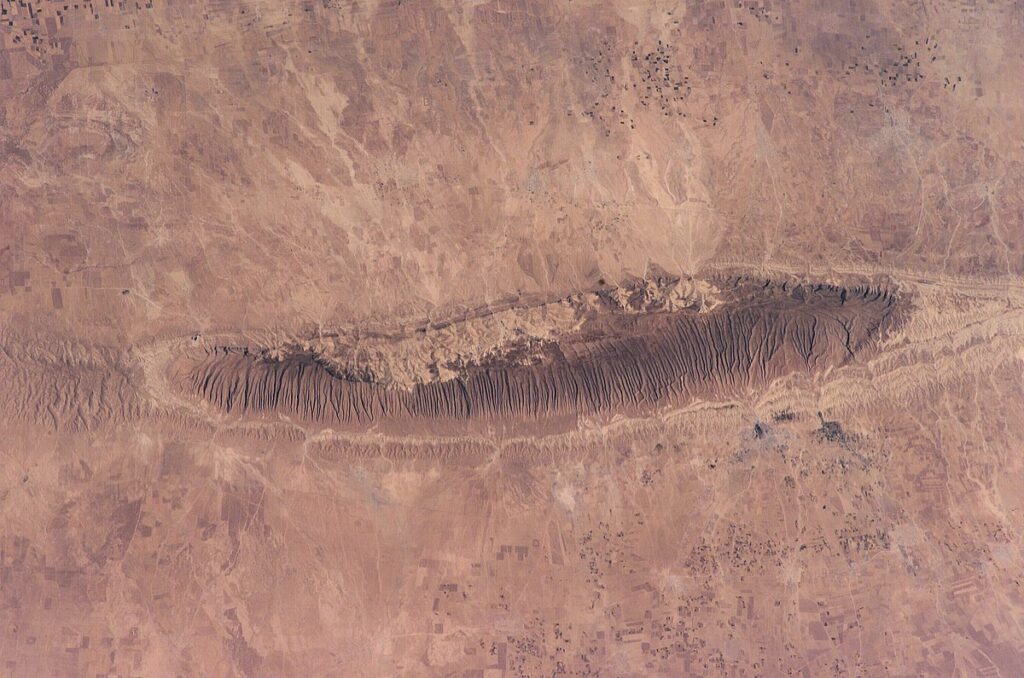The Yazidi are the most harshly persecuted minority group you’ve never heard of. For various reasons we will get into, very little ethnographic scholarship exists on the Yazidi. Because of this, a lot of their “canonical” definition as a people is a bit in flux right now. They are rapidly becoming a diaspora people, and need to adapt to survive. Very little conclusive information is available on the Yazidi, but they became a micro-fixation of mine for a time, and I figure I’d share what I learned. It’s pretty interesting–wild really. You literally won’t believe a lot of what you’re about to read and you will be frustrated in your attempts to fact check it. First of all, as I said, there’s little scholarship on the subject.

The best book I have been able to find about them is The Yezidi Oral Tradition in Iraqi Kurdistan by Christine Allison. Look at that price tag! That just goes to show you how scarce the high-quality sources are. What sources are most readily available are hardly reliable and colored heavily by politics. The Yazidi are a historically oppressed people, but they have perhaps never been more oppressed than they are in the present day. So what I am about to tell you is part of this huge big moment in geopolitics that’s going with regards to Kurdish nationalism, an ongoing genocide of a people who may or may not be Kurdish, and their struggle to survive. But I’m going to ask you to ignore all of that and not read this work in that context. For reasons that will become clear, some of the things about the Yazidi I am going to present have been used to justify their ongoing oppression. Let me just say once up front: I think it would be nice if the Yazidi could peacefully practice their beliefs in their ancestral lands forever. I don’t want anyone to use this work to justify any sort of oppression of the Yazidi people. On the contrary, I think all efforts should be taken to preserve them as a people at all cost.
These guys have had it rough for a long time. Disputed run ins with the Roman Empire and with the Rashidun Caliphate, well-documented oppression by the Ottomans (arguably even more particularly than the whole business with the Kurds and Armenians), attacked by Sadam Hussein, and, most recently, massacred and sold off into slavery by ISIS. Some Kurds regard the Yazidi as the original Kurdish tribe, but most reject them completely. They are incredibly insular; conversion to the Yazidi faith is not possible and marrying outside of the group is forbidden. They defy contemporary attempts by academics and journalists to define them because theirs is an oral tradition. Not only are there no canonical writings there are few writings period. What writings do exist are mostly from Islamic sources that crop up in the 12th century, and, in my opinion, academics are bit overly reliant on them.
So why all the hate? What’s the controversy? I know you’re dying to know. What I am about to tell you is the reason why they have been repeatedly targeted for millennia, but it is not an excuse! Just remember that. A lot of academics and journalists go out of their way to deny this simple fact because it has been used as this justification for genocide. But it can be true and they can still deserve to live as a people!
Ahhhh! I’ve dragged it out as long as I possibly can. You see, the thing is, these people… they uhhh… well… They worship the devil. They are, quite literally, a remote tribe of insular devil worshipers!

About the whole devil worship thing…
Enter the academics and journalists saying “this isn’t true. They don’t have the concept of the devil that Christians and Muslims have, yada yada yada.” And look, I get all of that. The more accurate thing to say would be: the Yazidi worship the being that Christians, Jews, and Muslims know as Satan. I’m about to get to the good part but first let’s do a brief primer on the Abrahamic Creation story so we can compare and contrast.
Oh! By the way, did I mention the Yazidi are NOT an Abrahamic religion? Tempting to classify them that way, but believe it or not they’re not. They are more closely related to Zoroastrainism in the Darwinian taxonomy of religions.
But I digress! Let’s sketch out the broad strokes of the Hebrew creation story, adopted broadly by Christians and Muslims alike. At the end of Creation God creates Man. Seeing His most perfect creation, he orders all of creation to bow before it, even the angels. Everyone complies, except for one, who is commonly known as Lucifer or Azazel. This angel is punished by getting kicked out of heaven. On Earth, he tempts Eve, the wife of Adam (who is the first man), who then tempts her husband. The two of them eat the Forbidden Fruit of the Tree of Knowledge of Good and Evil and the rest, as they say, is history! Satan is forever lurking, biting at the heels of men wreaking havoc in our world. A simplification, I know! But we have much ground to cover.
Now, let’s turn to the Yazidi story. As I said, it is an oral tradition. Oral traditions tend to have a bit more…plasticity, shall we say? There are multiple versions floating around, so this will be even more of a simplification than the rendition of Genesis (et al) above. But here we go: At the end of Creation God creates Man. He declares Man to be his greatest creation and orders all of creation to bow before it, even the angels. Everyone complies, except for one. this one is called Tawus Melek (and is associated with Azazel after contact with Islam). Only this time, it was a test! The right answer was to not bow before Man, because one should only bow before God. In another version he is punished for this, but redemption soon follows when, in both versions, that being gives the gift of the Fruit of Knowledge of Good and Evil to mankind. Either for passing the not-bowing test, or for leading Man out of paradise, Tawus Melek is put in charge of the whole Earth, and rules as a kind of proxy in God’s stead. Also worth noting, the Yazidi claim to be descendants of Adam, but not of Eve! An entire book could be written on that topic alone, but I’ll leave it here as a throw away.
These Yazidi worship this deity who is often in the form of a peacock or a black snake (pictured above). It is taboo for the Yazidi to kill a black snake because of this association. In one story, during the deluge in Genesis, the black snake plugged up a hole in the bottom of Noah’s ark and saved all of humanity.
They Worship the Devil–They Should Be Protected Anyway!
Look, I make it no secret: I actually believe in a literal way most of the stories from the Bible. Through this lens, the Yazidi are such a fascinating human treasure. Here you have an oral tradition from this indigenous group (whatever that means) that appear to have been living in this region since anyone lived there. You know their oral tradition is older than the Bible, because many of their religious practices and taboos are so heavily influenced by the now dead Zoroastrian religion, which predates Ezra’s Great Assembly by a long time.
And they agree broadly with the facts of creation! Where they differ is a matter of motive and impact of the events. As far as what happened at Creation–they agree!
These people are so fascinating and they have painstakingly maintained this unbroken oral history over millennia completely separate from the development of Hebrew, and later Christian, Rabbinic Judaic, and Islamic histories and when they all converged again they had such similar notes. So let’s talk about Tawus Melek, the peacock angel!

The most common manifestation of Tawus Melek is the peacock. It is interesting that the peacock has a plume that resembles many eyes, and biblical descriptions of angels, well… match up with that. It is also very interesting that the peacock is NOT a native bird to ANY Yazidi territories! What’s up with that? No one really knows. What we do know is that the Yazidi maintain seven peacock standards, just like the Roman Eagle Standards the Roman Empire used to bear. Every year, Yazidi people make pilgrimages to venerate these standards. Another manifestation of Tawus Melek, as I have said, is the image of a black serpent, and Yazidi temples are sometimes adorned with imagery of serpents near the entry ways.
There is a debate in the Abarahamic world, more intellectual than anything, about whether or not the Devil in fact did humanity a favor by leading humanity to eat from the Tree of Knowledge of Good and Evil. The Yazidi, evidently, come down on the side that it was in fact a net good. It was so laudable that God gave the Earth over to him to rule for this deed! The idea of the Devil running things in our earthly plane is not exclusive to the Yazidi, and many Jewish, Muslim, and Christian theologians have suggested the same–how else to you explain all the evil that runs amok in the world?
Now, academics, for many reasons, are not fans of oral sources. They like things written down, and I respect that. But it’s not always feasible to have a written source for everything. To me, the Yazidi are so fascinating, because their oral tradition fits in so well with so many other written sources from the time. Even the discrepancies seem to add up!
A common discrepancy anti-God people like to point with Genesis is that God first creates Man and Woman, but later creates Adam, and then Eve from his rib. Furthermore, when Cain is punished for murdering his brother Abel, he is worried he will be killed in his exile! Killed by whom exactly? Isn’t he among the only people alive at this point? Him and his parents and siblings anyway. Yet it’s clear in his exchange with God that there are in fact other people out there. And God agrees it’s likely they will kill Cain, so he puts a mark on Cain to alert people to, you know, not kill him.

Enter the Yazidi story. They are descendants of Adam, but not Eve. They appear to be a people divorced from the genealogies outlined in Genesis. Their origin story seems to fill in the gaps from the origin of the Abrahamic peoples provided by Genesis. Oh! And their lore of their sacred places!
The hotbed of Yazidi culture is around the area of Mt. Sinjar in Iraq. According to legend, this is the spot upon which Azazel either fell to from Heaven, or descended to on his own volition. It is the site of the fall of the first angel!

So you can see why people call them Devil worshipers. Now, academics will tell you, as I said, that they are not. They will tell you that in fact, the Yazidi are so tired by that stereotype that the word “Shaytan” (Satan in Arabic for the uninitiated) is so taboo that one mustn’t even pronounce it. That is how much they hate that guy! Or so they say.
But, if you are a student of theology and know a bit about the development of Zoroastrianism, Islam, Judaism, and Christianity, a different picture emerges. In Islam creating a likeness of the Prophet or Allah is the strictest taboo. In Judaism writing the name of God is a taboo, so they use the Tetragrammaton as a stand in. Indeed in English, some Jews won’t even write “God,” electing instead to use “G-d.” In a religious context, these sorts of taboos around names tend to be signs of veneration, not disgust. Indeed, proponents of Yazidi genocide often make that argument, so this data point about the Yazidi not saying the name of the devil seems to cut both ways.
I also think it’s interesting that pointing out that the Yazidi do in fact seem to worship the devil is regarded as genocide justifying hate-speech even in vacuum. Sure, I see why ISIS see’s it that way, but as liberal westerners can’t we acknowledge that the Yazidi deserve to live, regardless of who they worship?
The Yazidi are fading fast. They are being displaced, and are under the same sorts of pressures as the Hebrew people were in the time of Ezra’s Great Assembly. Because of that, like Ezra, many of them are interested in codifying their beliefs into a canonical text. It seems, then, that textualism in religion is a symptom of diaspora. As I said before, they have so many variants of their beliefs and narratives, so which will survive the diaspora and become canon?
How I found out about the Yazidi
I studied theology in college with a particular focus on Islam. In my studies, I had never heard of these guys. It seems very few people have! Because, again, there are so few sources about them. They were first put on my radar by a primary source: a veteran who had been stationed at the base of Mt. Sinjar to protect some communications array. Interesting how the US military always seems to have some strange strategic justification for holding some symbolic place, like the ancient city of Babylon, or in this case Sinjar. But I won’t get into that (this time).
So this guy was stationed there and he starts telling me about it and asks me if I’ve heard of the Yazidi. I tell him no! He tells me some crazy stuff and to be honest it was so long ago and a lot of it was so crazy that in the years since trying to fact-check his claims I have forgotten a lot of the original content. Remember, at the beginning o this post I told you the same thing would happen to you! What I do remember, is there were a number of taboos on the mountain that even US servicemen knew not to violate. He told me these people worshiped (in his words) Lucifer, but that they thought he was a good guy. He told me they were very polite and respectful people, but that he and many of his compatriots were nonetheless filled with an inexplicable sense of dread about entering certain parts of their territory.
And he told me the story about Sinjar. As he heard it, which I have NOT encountered in any of the sources I was able to examine, the mountain was actually created by the Earth reaching up to catch Lucifer who had been cast down from heaven. This mountain rises up to meet him, and, apparently, paradise is close by. He goes there, having been punished for not bowing to Adam, and convinces him voluntarily to leave paradise and enter the world at large. The Yazidi are born “from his seed,” but no mother of humanity is provided in the narrative.
And I don’t particularly struggle to believe his narrative. Melek Tawus is, in many sources, described as an “emanation of God” or “the Light of God” and, as we all know, Lucifer is the angel of light. Sinjar is clearly sacred to these people for some reason, and it being the site of the arrival of their deity is as good a reason as any. He’s also a pretty trust worthy guy.
To me, their history and their story is a valuable data point in mapping human prehistory and our cosmology. The Yazidi are in trouble right now, and I sincerely hope they and their way of life and stories can survive.
